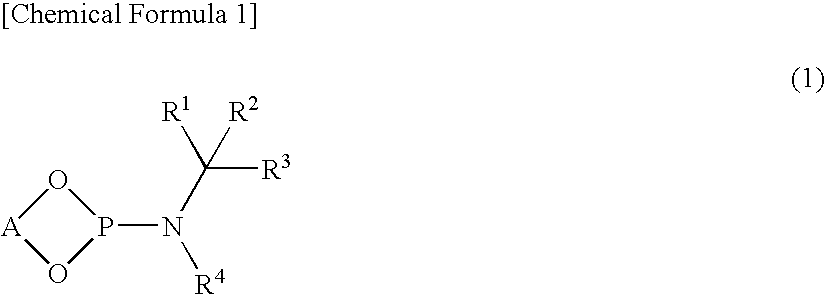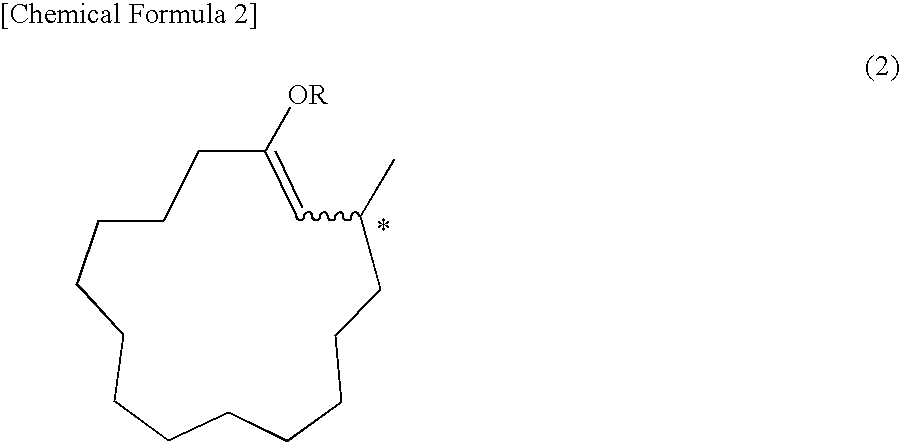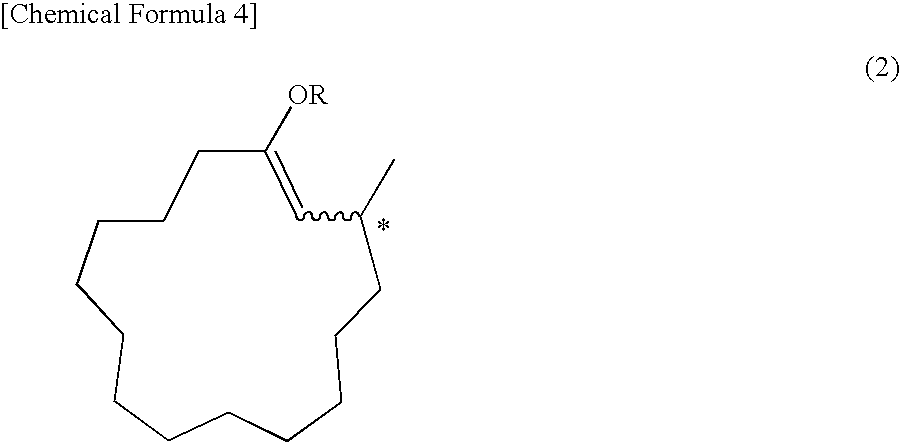Optically active 3-methylcyclopentadecanone and method for producing intermediate thereof
a technology of optically active and cyclopentadecanone, which is applied in the preparation of carbonyl compounds, organic chemistry, and group 5/15 element organic compounds, etc., can solve the problems of unavoidable generation of (s)-isomers, natural musk cannot be used in the future, etc., and achieves simple structure, easy production, and suppression of intermolecular side reactions of generated enol anions
- Summary
- Abstract
- Description
- Claims
- Application Information
AI Technical Summary
Benefits of technology
Problems solved by technology
Method used
Image
Examples
example 1
Synthesis of O,O′—(R)-(1,1′-binaphthalene-2,2′-diyl)-N-benzyl-N—(R)-(1-p henylethyl)phosphoramidite (L-1) Represented by the Following Chemical Formula
[0127]
[0128]Under a nitrogen gas stream, a solution of 20 mL of THF and 1.05 g (5.0 mmol) of (R)-(+)-N-benzyl-N-(1-phenylethyl)amine was introduced to a 50-mL three-necked flask equipped with a thermometer and a dropping funnel, the solution was cooled to −50° C., and 3.2 mL (5.0 mmol) of n-butyllithium (1.58 M hexane solution) was added dropwise. After stirring the mixture at −50° C. for 1 hour, 6.8 g (50 mmol) of phosphorus trichloride was added, and the mixture was gradually warmed to room temperature, and then stirred for 2 hours. Subsequently, the solvent and phosphorus trichloride were removed under reduced pressure, and 20 mL of toluene was added to the residue. This toluene solution was cooled to −20° C., and a mixed solution of 1.43 g (5.0 mmol) of (R)-(+)-1,1-bi(2-naphthol), 2.53 g (25 mmol) of triethylamine and 10 mL of tol...
example 2
Synthesis of (R)-3-methyl-1-cyclopentadecenyl Propionate Represented by the Following Chemical Formula
[0132]
[0133]In a nitrogen atmosphere, 21.0 mg (0.04 mmol) of the optically active ligand obtained in Example 1, O,O′—(R)-(1,1′-binaphthalene-2,2′-diyl)-N-benzyl-N—(R)-(1-p henylethyl)phosphoramidite, 7.2 mg (0.02 mmol) of Cu(OTf)2 and 7 mL of toluene were introduced into a 30-mL reaction flask equipped with a thermometer, and the mixture was stirred at room temperature for 30 minutes. 1.4 mL (2.8 mmol) of a toluene solution of dimethylzinc (2.0 mol / L) was added to the solution, and the mixture was stirred for 30 minutes. Subsequently, the solution was cooled to −20° C., and 0.29 g (2.2 mmol) of propionic anhydride and 0.44 g (2.0 mmol) of 2-(E)-cyclopentadecenone were added dropwise. After completion of the dropwise addition, the mixture was stirred for 2 hours, the reaction was stopped by adding a 5% aqueous solution of sulfuric acid, and liquid partition was performed. The organic...
example 3
Synthesis of (R)-Muscone Represented by the Following Formula
[0137]
[0138]0.53 g (1.8 mmol) of (R)-3-methyl-1-cyclopentadecenyl propionate obtained in Example 2 and 20 g of toluene were introduced into a 30-mL recovery flask, and the mixture was stirred. 0.39 g (2.0 mmol) of a 28% methanol solution of sodium methoxide was added dropwise at 20° C., and then the mixture was stirred for 1 hour. Subsequently, a 5% aqueous solution of sulfuric acid was added to the reaction liquid, and then liquid partition was performed. The organic layer was washed with water, and then the solvent was removed under reduced pressure, to obtain 0.60 g of a crude product. This crude product was purified by silica gel column chromatography to obtain (R)-muscone with a yield of 97%. The optical purity was measured by high performance liquid chromatography, and the result was 86.1% ee.
PUM
| Property | Measurement | Unit |
|---|---|---|
| temperature | aaaaa | aaaaa |
| temperature | aaaaa | aaaaa |
| temperature | aaaaa | aaaaa |
Abstract
Description
Claims
Application Information
 Login to View More
Login to View More - R&D
- Intellectual Property
- Life Sciences
- Materials
- Tech Scout
- Unparalleled Data Quality
- Higher Quality Content
- 60% Fewer Hallucinations
Browse by: Latest US Patents, China's latest patents, Technical Efficacy Thesaurus, Application Domain, Technology Topic, Popular Technical Reports.
© 2025 PatSnap. All rights reserved.Legal|Privacy policy|Modern Slavery Act Transparency Statement|Sitemap|About US| Contact US: help@patsnap.com



